
Shutterstock.com
Childhood vaccination coverage declined in 9 of the 12 routine vaccinations measured at the ages of one, two or five years in 2017/2018, compared with the previous year, according to statistics released by Public Health England (PHE).
Coverage of the measles, mumps and rubella (MMR) vaccine for children reaching their second birthday decreased for the fourth year in a row and is now at 91.2%, the lowest it has been since 2011/2012.
National coverage figures reported for the MMR first dose as measured at five years showed coverage was 94.9% in 2017/2018, not quite reaching the target level of 95% recommended by the World Health Organization (WHO), which was met for the first time in 2016/2017. Uptake of the second MMR dose by the age of five years was 87.2%, below the WHO target of 95% that is required to sustain elimination in the long term.
Statistics for infant meningitis B (MenB) vaccinations were also reported for the first time since it was introduced in September 2015, and highlighted that 92.5% coverage has been achieved.
Some regional variation in coverage across the UK was found, with levels of immunisation for all routine childhood vaccinations reported as highest in the North East of England and lowest in London.
The most recent change to the primary immunisation schedule is the replacement of the pentavalent vaccine (DTaP/IPV/Hib) — against diphtheria, tetanus, pertussis, polio and Haemophilus influenzae type b — with a hexavalent vaccine that includes hepatitis B (DTaP/IPV/Hib/HepB) for all babies born on or after 1 August 2017, which will be assessed as part of the annual data collection in 2018/2019.


